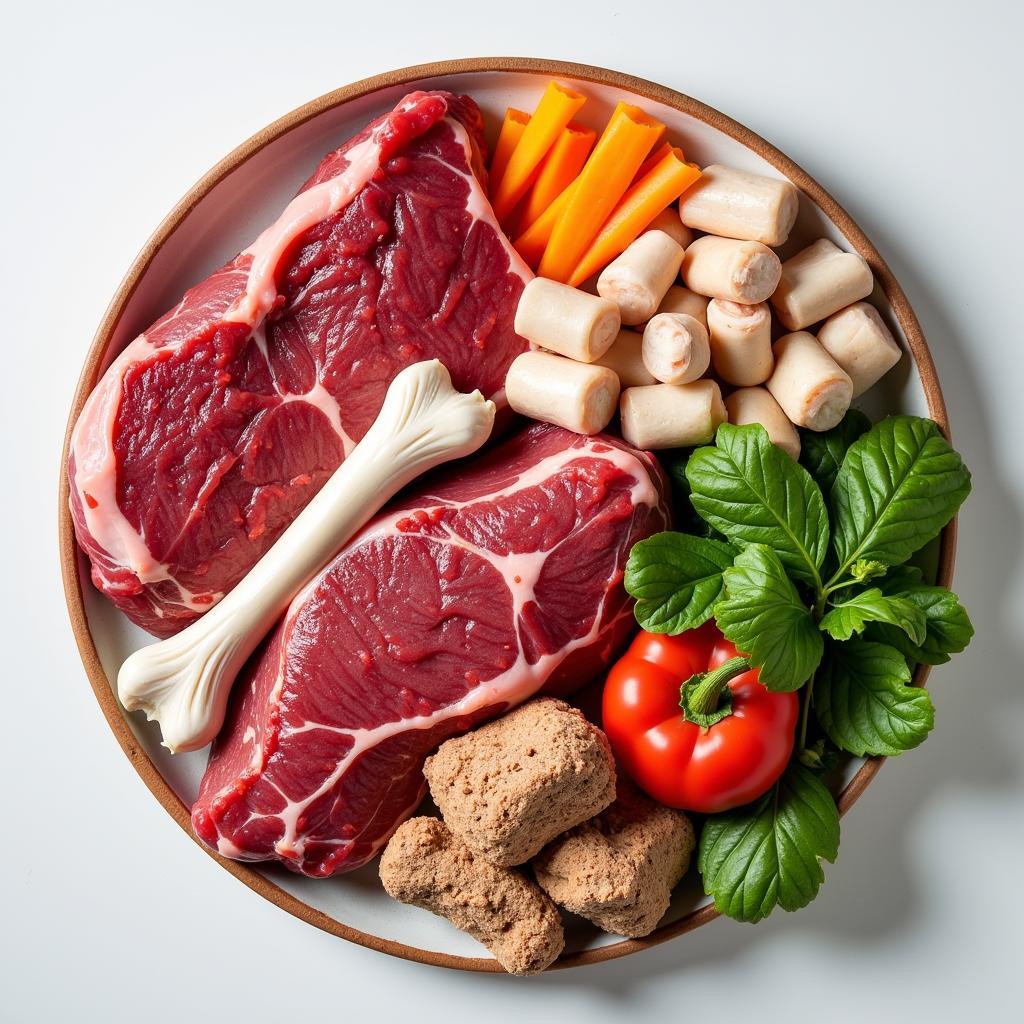Knowing How Much Raw Dog Food To Feed is crucial for your furry friend’s health and well-being. Feeding the correct amount ensures your dog receives the necessary nutrients without becoming overweight or undernourished. This comprehensive guide will delve into the intricacies of raw feeding, empowering you to make informed decisions about your dog’s diet. Let’s explore the world of raw dog food portioning together. Check out some of our best recommendations for best fido friend dog food.
Factors Affecting Raw Dog Food Portions
Several factors influence the ideal raw dog food portion for your pet. Understanding these variables will allow you to tailor a feeding plan specifically for your dog’s needs.
Activity Level
A highly active dog, like a working breed or a sporting dog, requires more calories than a less active dog. Consider their daily exercise routine and adjust their food intake accordingly. A sedentary dog may only need a smaller portion of raw food to maintain a healthy weight.
Age
Puppies, adult dogs, and senior dogs have different nutritional requirements. Growing puppies need more calories and nutrients to support their development, while senior dogs may require fewer calories and a diet tailored to their age-related needs.
Breed and Size
Larger breeds naturally require more food than smaller breeds. Similarly, the specific breed can also influence dietary needs. Some breeds are predisposed to certain health conditions that may necessitate adjustments to their diet. Are you thinking of starting your puppy on a raw food diet? Check out our article on stewart freeze dried puppy food.
Calculating Raw Dog Food Portions
While general guidelines exist, calculating the precise amount of raw dog food can seem daunting. A simple rule of thumb is to feed your adult dog 2-3% of their ideal body weight per day. For puppies, this can range from 5-10% depending on their age and breed.
The 2-3% Rule
The 2-3% rule offers a starting point. For example, a 50-pound adult dog would need between 1 and 1.5 pounds of raw food daily. This can be divided into two meals for optimal digestion. Remember, this is a guideline, and adjustments may be necessary based on individual factors.
Monitoring Your Dog’s Weight and Condition
Regularly monitoring your dog’s weight and body condition is key to ensuring they are receiving the correct amount of food. If your dog is gaining weight, slightly reduce their portions. Conversely, if they are losing weight, a slight increase might be necessary. A healthy dog should have a visible waist and ribs that are easily felt but not seen.
Common Raw Feeding Mistakes
Avoid these common pitfalls when embarking on a raw feeding journey with your furry friend:
- Overfeeding: Overfeeding can lead to obesity and other health problems.
- Underfeeding: Underfeeding can result in nutrient deficiencies and weight loss.
- Not balancing the diet: A balanced raw diet should include muscle meat, organ meat, and bone.
- Ignoring individual needs: Each dog is unique, and their diet should reflect their specific requirements.
How Much Does Raw Dog Food Cost?
One frequent question surrounding raw feeding is the cost. While it can be more expensive than kibble, many owners find the health benefits worth the investment. For more detailed information on raw food costs, check out our article on how much does raw dog food cost per month.
 Balanced Raw Dog Food Meal
Balanced Raw Dog Food Meal
“A balanced raw diet is essential for providing dogs with optimal nutrition,” says Dr. Emily Carter, a veterinary nutritionist with over 15 years of experience. “It allows dogs to thrive by mimicking their ancestral diet.”
Transitioning to a Raw Diet
Transitioning your dog to a raw food diet should be done gradually. Start by introducing small amounts of raw food alongside their current diet and slowly increase the proportion of raw food over several days or weeks. This allows their digestive system to adjust to the change. If you’re interested in incorporating a variety of proteins, explore our article on multi protein dog food.
Conclusion
Determining how much raw dog food to feed your canine companion involves careful consideration of individual factors, including age, breed, size, and activity level. By following the guidelines and monitoring your dog’s weight and condition, you can ensure they receive the optimal nutrition they need to thrive. Remember, transitioning to raw should be gradual, and a balanced diet is key.
FAQs
- What if my dog refuses to eat raw food? Try different protein sources or add a small amount of bone broth to entice them.
- Is raw food safe for puppies? Yes, but it’s crucial to ensure a balanced diet formulated for their growing needs.
- Can I mix raw food with kibble? While not ideal, it’s sometimes done during the transition period.
- Where can I buy raw dog food? Raw dog food can be purchased at specialty pet stores, online retailers, and some butcher shops.
- How do I store raw dog food? Store raw dog food in the freezer and thaw portions as needed.
- What are the signs of a nutritional deficiency in dogs? Signs can include weight loss, poor coat condition, lethargy, and digestive issues.
- Should I consult with a vet before switching to raw feeding? Yes, consulting a veterinarian is always recommended before making significant dietary changes.
“Always observe your dog’s individual response to raw feeding,” advises Dr. Mark Johnson, a holistic veterinarian with 20 years of experience. “Adjustments may be needed to ensure they’re thriving on their new diet.” For those interested in a specific protein percentage for their dog, you can visit our article on showtime dog food 24/20.
Need more help? Contact us at Phone Number: 02437655121, Email: minacones@gmail.com Or visit us at: 3PGH+8R9, ĐT70A, thôn Trung, Bắc Từ Liêm, Hà Nội, Việt Nam. We have a 24/7 customer service team.